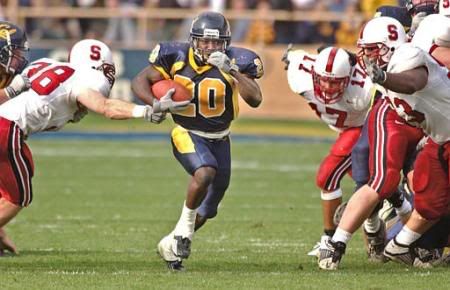The number of Black head coaches in NCAA Division 1A football almost doubled this offseason.
NB: I was impressed by this ESPN article, until I noticed that it was listed under BLACKHISTORY in the HTML title (and the URL is for blackhistory/news). Of course issues of race and racism in football are only news in February; silly me.
The title of this post bears repeating: the number of Black head coaches in NCAA Division 1A football nearly doubled this offseason.
It increased from 3 to 5, with the hiring of Ron Price at Kansas State and Turner Gill at Buffalo; there are 119 NCAA D1A teams playing football, and every single one of them has a head coach. Price and Gill join current coaches Tyrone Willingham (Washington), Karl Dorrell (UCLA), and Sylvester Croom (Mississippi State). (As an aside, I find it very interesting that the Pac-10 has two black head coaches for its 10 teams, while the SEC and ACC, both resident in the South, only have one black head coach between them for their 24 teams.) According to the Institute for Diversity and Ethics in Sports, a clear plurality of football players at the Division 1A level are black (over 49%; 46% of players are white), so this discrepancy — from almost 50% of players to just over 4% of coaches — is fairly egregious.
The Black Coaches Association has striven to include minority candidates in job searches for years, and even with their efforts a number of high-profile jobs every year go to white candidates with no real effort to interview potential black coaches. The recent vacancies at Florida and Colorado used this method.
Kansas State athletic director Tim Weiser told ESPN,
I don't know that I can give you a particular reason why there seem to be more. Previously, they either didn't have somebody that was putting their name out there or perhaps weren't as active in making some of the network connections that you have to do in this profession. Many times it is who you know that puts you in positions for these jobs. I don't know if the group has done a better job through the Black Coaches Association of promoting themselves and making themselves known to ADs and commissioners and people who are going to be in position to make hires.He makes several fascinating points: hiring in such a small community is dependent on who you know; networking is hugely important, and it has, for a variety of reasons, probably often excluded minorities; and there is a startling lack of institutional support for qualified candidates.
Jon Embree, a qualified candidate who wasn't hired for any of the many vacancies over the last several years calls it "selective criteria. If you go into a search you [can] set up the criteria in such a way you can eliminate all black candidates," without making it explicitly about race. For instance, if a school decides to only hire people with previous head coaching experience, then they disqualify almost all the black candidates.
The situation as it stands now is extremely exploitative to the young black men who provide the bulk of the collegiate sports entertainment industry.
One solution to the problem might be to discuss the issue in August as well as February (and also in October and January and April). A second solution might be to include NCAA sanctions (scholarship reductions, fines, or limiting television revenue) for schools which receive a failing grade from the BCA during their hiring processes. Another possibility might be for the NCAA to organize and mandate quotas for assistant coaches pegged to the percentages of players.
For now, though, we can be happy that there are almost twice as many black head coaches today as there were 12 months ago.
Division 1A Football Statistics*:
| Student Athletes | Assistant Coaches | Coordinators (Off & Def) | Head Coaches | Athletic Directors | |
| White | 46.7% | 72.1% | 88% | 97.5% | 89.1% |
| Black | 49.2% | 26.1% | 10% | 2.5% | 8.4% |
| Asian | 2.2% | 1.2% | 1.2% | 0% | NA |
| Latino | 1.8% | 0.6% | 0.8% | 0% | NA |
| Other | 0.1% | 0% | 0% | 0% | NA |
*Source: ESPN and the Institute for Diversity and Ethics in Sports; data from November 2005.

